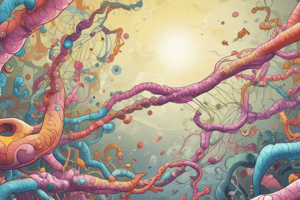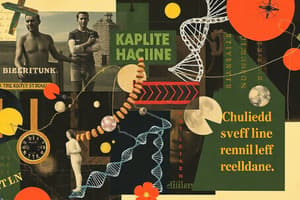Podcast
Questions and Answers
What is the role of rRNA in protein synthesis?
What is the role of rRNA in protein synthesis?
- to encode the amino acid sequence of a gene
- to form the structural components of ribosomes (correct)
- to transfer amino acids to a growing polypeptide chain
- to read the information encoded in mRNA
What is the difference between transcription and replication in terms of the template?
What is the difference between transcription and replication in terms of the template?
- Transcription uses both DNA strands as templates, while replication uses only one.
- Transcription uses a primer, while replication does not.
- Transcription uses only one DNA strand as a template, while replication uses both. (correct)
- Transcription uses a RNA template, while replication uses a DNA template.
What is the function of the promoter in transcription?
What is the function of the promoter in transcription?
- to elongate the transcript
- to unwind the DNA duplex
- to terminate transcription
- to initiate transcription (correct)
What is the result of changes in DNA supercoiling during transcription?
What is the result of changes in DNA supercoiling during transcription?
What is the length of the transcription 'bubble' during transcription?
What is the length of the transcription 'bubble' during transcription?
What is the role of the 8 bp RNA-DNA hybrid in transcription?
What is the role of the 8 bp RNA-DNA hybrid in transcription?
What is the equation for RNA synthesis during transcription?
What is the equation for RNA synthesis during transcription?
What is the role of DNA-dependent RNA polymerase in transcription?
What is the role of DNA-dependent RNA polymerase in transcription?
What is the length of the region of DNA that is unwound during the initiation of transcription?
What is the length of the region of DNA that is unwound during the initiation of transcription?
What is the direction of movement of the Rho factor during Rho-dependent termination of transcription?
What is the direction of movement of the Rho factor during Rho-dependent termination of transcription?
What is the characteristic of the sequence of repeated residues found in Rho-independent termination sites?
What is the characteristic of the sequence of repeated residues found in Rho-independent termination sites?
What is the outcome of the formation of a stem and loop structure (hairpin structure) during transcription?
What is the outcome of the formation of a stem and loop structure (hairpin structure) during transcription?
What is the nature of the AUU hybrid region at the 3' end of the new transcript during transcription termination?
What is the nature of the AUU hybrid region at the 3' end of the new transcript during transcription termination?
What is the role of the Rho factor during Rho-dependent termination of transcription?
What is the role of the Rho factor during Rho-dependent termination of transcription?
What is the outcome of the unwinding of the 12 to 15 bp region of DNA during the initiation of transcription?
What is the outcome of the unwinding of the 12 to 15 bp region of DNA during the initiation of transcription?
What is the location of the Rho-independent termination site in a DNA sequence?
What is the location of the Rho-independent termination site in a DNA sequence?
What is the rate of RNA polymerase transcription in E. coli?
What is the rate of RNA polymerase transcription in E. coli?
What is the function of topoisomerases in transcription?
What is the function of topoisomerases in transcription?
What is the sequence of the RNA transcript compared to the nontemplate strand?
What is the sequence of the RNA transcript compared to the nontemplate strand?
What is the function of the sigma factor in RNA polymerase?
What is the function of the sigma factor in RNA polymerase?
What is the recognition sequence at the -10 region of E. coli promoters?
What is the recognition sequence at the -10 region of E. coli promoters?
What is the effect of variations in the consensus sequence of E. coli promoters?
What is the effect of variations in the consensus sequence of E. coli promoters?
What is the state of the promoter DNA during transcription initiation?
What is the state of the promoter DNA during transcription initiation?
What is the region of the promoter that extends between positions -70 and +30?
What is the region of the promoter that extends between positions -70 and +30?
What is the primary function of RNA polymerase I in eukaryotes?
What is the primary function of RNA polymerase I in eukaryotes?
What is the role of transcription factors in RNA polymerase II-mediated transcription?
What is the role of transcription factors in RNA polymerase II-mediated transcription?
What is the function of the TATA box in eukaryotic promoters?
What is the function of the TATA box in eukaryotic promoters?
Which of the following is a subunit of RNA polymerase II?
Which of the following is a subunit of RNA polymerase II?
What is the outcome of the phosphorylation of the carboxyl-terminal domain of the Pol II subunit?
What is the outcome of the phosphorylation of the carboxyl-terminal domain of the Pol II subunit?
What is the role of TFIIH in RNA polymerase II-mediated transcription?
What is the role of TFIIH in RNA polymerase II-mediated transcription?
What is the outcome of the transcription process at RNA polymerase II promoters?
What is the outcome of the transcription process at RNA polymerase II promoters?
What is the sequence of events during transcription at RNA polymerase II promoters?
What is the sequence of events during transcription at RNA polymerase II promoters?
What is the primary function of TFIIH in response to DNA lesions?
What is the primary function of TFIIH in response to DNA lesions?
What is the consequence of the genetic loss of TFIIH?
What is the consequence of the genetic loss of TFIIH?
What is the primary function of the 5' cap in mRNA modification?
What is the primary function of the 5' cap in mRNA modification?
What is the consequence of alternative splicing in mRNA modification?
What is the consequence of alternative splicing in mRNA modification?
What is the primary function of polyadenylation in mRNA modification?
What is the primary function of polyadenylation in mRNA modification?
What is the mechanism of action of intercalating agents, such as actinomycin?
What is the mechanism of action of intercalating agents, such as actinomycin?
What is the mechanism of action of rifampicin in bacterial RNA synthesis?
What is the mechanism of action of rifampicin in bacterial RNA synthesis?
What is the consequence of RNA polymerase II halting at the site of a DNA lesion?
What is the consequence of RNA polymerase II halting at the site of a DNA lesion?
Flashcards are hidden until you start studying
Study Notes
RNA Metabolism
- RNA plays three roles in protein synthesis: mRNA encodes amino acid sequence, tRNA reads mRNA and transfers amino acids, and rRNA is a constituent of ribosomes.
RNA Synthesis
- RNA synthesis is carried out by DNA-dependent RNA polymerase, which acts as a nucleophile attacking the phosphate of incoming rNTPs.
- Transcription resembles replication in its fundamental chemical mechanism, with polarity, template use, and initiation, elongation, and termination phases.
- Transcription differs from replication in not requiring a primer and involving only limited segments of a DNA molecule.
Initiation of Transcription
- Initiation starts at a promoter, where the DNA duplex unwinds, forming a transcription "bubble" of about 17 bp.
- The RNA-DNA hybrid occurs in this unwound region, and the transcription bubble moves along the DNA, generating waves of positive supercoils ahead and negative supercoils behind.
Elongation of Transcription
- Elongation of a transcript proceeds at a rate of 50-90 nucleotides/s.
- Movement of the transcription bubble requires considerable strand rotation of the nucleic acid molecules.
- Topological problems caused by transcription are relieved by topoisomerases.
RNA Polymerase
- RNA polymerase holoenzyme consists of five core subunits and a sigma factor, which directs the enzyme to specific binding sites on the DNA.
- The enzyme lacks 3'>5' proofreading activity.
Promoters
- E. coli promoters have several recognition sequences, including the -10 and -35 regions, and the UP element.
- The promoter region extends between positions -70 and +30.
- Variations in the consensus sequence affect the efficiency of RNA polymerase binding and transcription initiation.
Termination of Transcription
- Termination occurs in two ways: Rho-independent and Rho-dependent.
- Rho-independent termination occurs at characteristic sequences, including a stem and loop structure.
- Rho-dependent termination involves the Rho factor, which is an ATP-dependent helicase that associates with the RNA and migrates in the 5'>3' direction.
Eukaryotic RNA Polymerases
- There are three eukaryotic RNA polymerases: RNA pol I, RNA pol II, and RNA pol III.
- RNA pol I synthesizes pre-rRNA, which contains the precursor for the 18S, 5.8S, and 28S rRNAs.
- RNA pol II synthesizes mRNAs and requires an array of transcription factors.
- RNA pol III synthesizes tRNAs, the 5S rRNA, and some other small specialized RNAs.
Promoters in Eukaryotes
- Promoters in eukaryotes have a TATA box and an Inr region.
- The TATA box is a pyrimidine-rich sequence that is recognized by the TBP protein.
- The Inr region is a sequence that is recognized by the RNA polymerase.
RNA Polymerase II
- RNA pol II is a huge enzyme consisting of 12 subunits.
- The carboxyl-terminal domain (CTD) of the RPB1 subunit is phosphorylated by TFIIH during transcription initiation.
Transcription at RNA Polymerase II Promoters
- Transcription at RNA polymerase II promoters involves the sequential assembly of transcription factors, including TBP, TFIIB, TFIIF, and TFIIH.
- The DNA is unwound at the Inr region by the helicase activity of TFIIH, and the polymerase then escapes the promoter and begins elongation.
mRNA Modification in Eukaryotes
- mRNA modification in eukaryotes involves three steps: capping, splicing, and polyadenylation.
- Capping occurs before the synthesis of the primary transcript is complete.
- Splicing involves the removal of introns and the joining of exons to form a continuous sequence.
- Polyadenylation involves the addition of 80-250 A residues to the 3' end of the mRNA.
Modified RNA
- RNA polymerase can undergo selective inhibition by certain agents, including intercalating agents and rifampicin.
- Intercalating agents, such as actinomycin, intercalate into the double-helical DNA, deforming the DNA and inhibiting RNA elongation.
- Rifampicin inhibits bacterial RNA synthesis by binding to the B subunit of bacterial RNA polymerases, preventing the promoter clearance step of transcription.
Studying That Suits You
Use AI to generate personalized quizzes and flashcards to suit your learning preferences.




